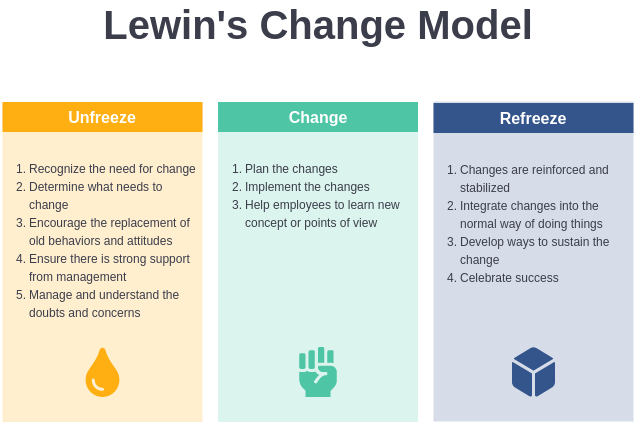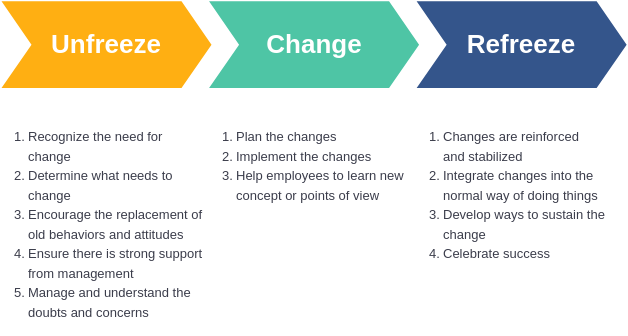What is Lewin’s three-stage change process model?
Many models have been developed to explain organizational change. One of the earliest models was developed by Kurt Lewin, a German psychologist and researcher on communication and organizational development. Lewin’s three-step approach views change as a break in organizational equilibrium, or a thaw. Once the thaw is complete, the change itself can be introduced, but simply introducing the change does not ensure that the change will last; the new state needs to be refrozen. The new state needs to be refrozen so that it can be maintained for a significant period of time. Thus, the purpose of refreezing is to stabilize the new state by balancing the two forces of driving and binding forces.
Lewin’s three stages of change
The 3-stage model of change describes the current state as the status quo. It presents the change process and then starts with the proposed change and then evolves to the desired future state.
According to Lewin, change in organizations can go through three basic stages:

Phase 1: Unfreezing – Creating the momentum for change
The organization must wake up to the new reality, break with the past, and acknowledge that the old way of doing things is no longer acceptable. It will be very difficult for the organization to embrace a new vision of the future until it separates itself from the structures and management behaviors that no longer work and that it will seek to break.
- Current behaviors or attitudes must be definitively denied or no longer reinforced or affirmed for a period of time.
- This denial must establish a sufficient sense of urgency to produce change.
- Create psychological security by reducing barriers to change or by reducing the fear of failure.
Phase 2: Change – indicates the direction of change and implements the change so that members develop new attitudes and behaviors.
The organization creates and owns a vision of the future and integrates the steps needed to reach that goal. One of the first steps in orchestrating change is to unite the entire organization under a cohesive vision. This vision not only includes some statement of its mission, philosophy and strategic goals, but it is designed to very clearly outline what the organization should ideally look like in the future. It is likened to “organizational dreaming – using the imagination to encourage people to rethink what is possible”.
- Identification with the role model. That is, the most effective way to learn a new perspective or establish a new attitude is to watch how others do it and to use that person as a role model for developing new attitudes or behaviors.
- Selecting multiple pieces of information from objective reality and sifting through the complexity of the environment to find information about one’s particular problem.
Stage 3: Refreezing – Stabilizing Change
As new attitudes, practices and policies are used to change the company, they must be “refreezed” or solidified. Refreezing stabilizes the organization in a new equilibrium to ensure that the new way of working does not change easily, and it reinforces the new behaviors that underpin the change.
- Giving members the opportunity to test whether the new attitudes and behaviors fit their specific situation. The member’s initial buy-in to the role model may be minimal and should be sustained with encouragement.
- Give the member the opportunity to test the acceptance and affirmation of the new attitude by others with whom he has a significant relationship. The new attitudes and behaviors of individuals can be maintained somewhat longer as group members reinforce them with each other.

The Purpose of Lewin’s Change Model
It is a constant fact that any business needs constant growth and change. This could be due to the growth of companies, changes in consumer demand or government policies, or advances in technology. Lewin’s change management theory helps explain the uncertainty and resistance of change that all employees in an organization may experience. Lack of cooperation among employees and widespread distrust of unproven processes are common obstacles to change. In order for us to successfully transition from the “present” state to the “expected” state, it is helpful to apply change management methods such as Kurt Lewin’s theory.`
One of the constants of any business is the need for regular growth and change. This may be due to company growth, changes in consumer demand or government policy, or advances in technology. Lewin’s theory of change management helps explain the uncertainty and resistance to change that all employees in an organization may experience. Lack of collaboration among employees and a general distrust of unproven processes are common barriers to achieving change. In order for us to successfully transition from the “current” state to the “desired” state, it is helpful to apply change management methods such as Kurt Lewin’s theory.
One of the constants of any business is the need for regular growth and change. This may be due to the growth of the company, changes in consumer demand or government policy, or advances in technology. Lewin’s change management theory helps explain the uncertainty and resistance to change that all employees in an organization may experience. Lack of collaboration among employees, a general distrust of unproven processes are common barriers to achieving change, so that we can successfully transition from the “current” state to the “expected” state, it is helpful to apply change management methods, such as Kurt Lewin’s theory.
Lewin’s model of organizational change laid the foundation for the study of organizational change theory, and his model of this typical three-part process has since been inherited and developed by many organizational change scientists. It is widely accepted that there is a typical organizational change process model consisting of 3 parts: selecting a flawed organization, allowing it to pass through difficult transitional stages, and eventually precipitating it into the desired state of abundance.
Infographics Tool and Templates
Visual Paradigm Online (VP Online) is an online diagramming software that supports Lewins Change Model and many other diagrams such as UML, Org Chart, Floor Plan, wireframe, family tree, ERD, etc. You can easily draw Lewin’s Change Model with a simple and intuitive chart editor.
Lewin Model of Change










